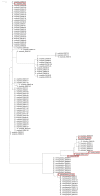Comparison of Clinical Manifestations, Antimicrobial Susceptibility Patterns, and Mutations of Fluoroquinolone Target Genes between Elizabethkingia meningoseptica and Elizabethkingia anophelis Isolated in Taiwan
- PMID: 30545016
- PMCID: PMC6306790
- DOI: 10.3390/jcm7120538
Comparison of Clinical Manifestations, Antimicrobial Susceptibility Patterns, and Mutations of Fluoroquinolone Target Genes between Elizabethkingia meningoseptica and Elizabethkingia anophelis Isolated in Taiwan
Erratum in
-
Correction: Jiun-Nong Lin; Chung-Hsu Lai; Chih-Hui Yang and Yi-Han Huang. Comparison of Clinical Manifestations, Antimicrobial Susceptibility Patterns, and Mutations of Fluoroquinolone Target Genes between Elizabethkingia meningoseptica and Elizabethkingia anophelis Isolated in Taiwan. Journal of Clinical Medicine 2018, 7, 538.J Clin Med. 2019 Apr 22;8(4):546. doi: 10.3390/jcm8040546. J Clin Med. 2019. PMID: 31013674 Free PMC article.
Abstract
Elizabethkingia meningoseptica and Elizabethkingia anophelis are two major pathogens in the genus Elizabethkingia. Studies have revealed that Elizabethkingia anophelis is frequently misidentified as E. meningoseptica. Therefore, our aim was to explore the clinical and molecular differences between these two species. The database of a clinical microbiology laboratory in a university-affiliated hospital of Taiwan was searched to identify patients with Elizabethkingia infections between January 2005 and June 2018. Species were reidentified using 16S ribosomal RNA gene sequencing. Twenty E. meningoseptica and 72 E. anophelis samples were collected from consecutive patients. E. meningoseptica was significantly more frequently isolated from the cerebrospinal fluid than was E. anophelis. The most susceptible antibiotic for all Elizabethkingia isolates was minocycline (91.3%), followed by levofloxacin (52.2%), tigecycline (23.9%), and piperacillin tazobactam (23.9%). Compared with E. anophelis, E. meningoseptica was significantly less susceptible to piperacillin tazobactam, minocycline, and levofloxacin. Regarding nonsynonymous substitutions in the quinolone-resistance determining regions of DNA gyrase, six sites were recognized in E. meningoseptica and one site was recognized in E. anophelis. E. meningoseptica had a significantly higher rate of fluoroquinolone target gene mutations than did E. anophelis. Because of less susceptibility to multiple antibiotics than E. anophelis, empirical antimicrobial therapy of E. meningoseptica should be more rigorous.
Keywords: Elizabethkingia anophelis; Elizabethkingia meningoseptica; drug resistance; fluoroquinolone; quinolone-resistance determining region.
Conflict of interest statement
The authors declare no conflict of interest.
Figures

References
-
- Nicholson A.C., Gulvik C.A., Whitney A.M., Humrighouse B.W., Graziano J., Emery B., Bell M., Loparev V., Juieng P., Gartin J., et al. Revisiting the taxonomy of the genus Elizabethkingia using whole-genome sequencing, optical mapping, and MALDI-TOF, along with proposal of three novel Elizabethkingia species: Elizabethkingia bruuniana sp. nov., Elizabethkingia ursingii sp. nov., and Elizabethkingia occulta sp. nov. Anton. Van Leeuwenhoek. 2017;111:55–72. doi: 10.1007/s10482-017-0926-3. - DOI - PMC - PubMed
Grants and funding
LinkOut - more resources
Full Text Sources

